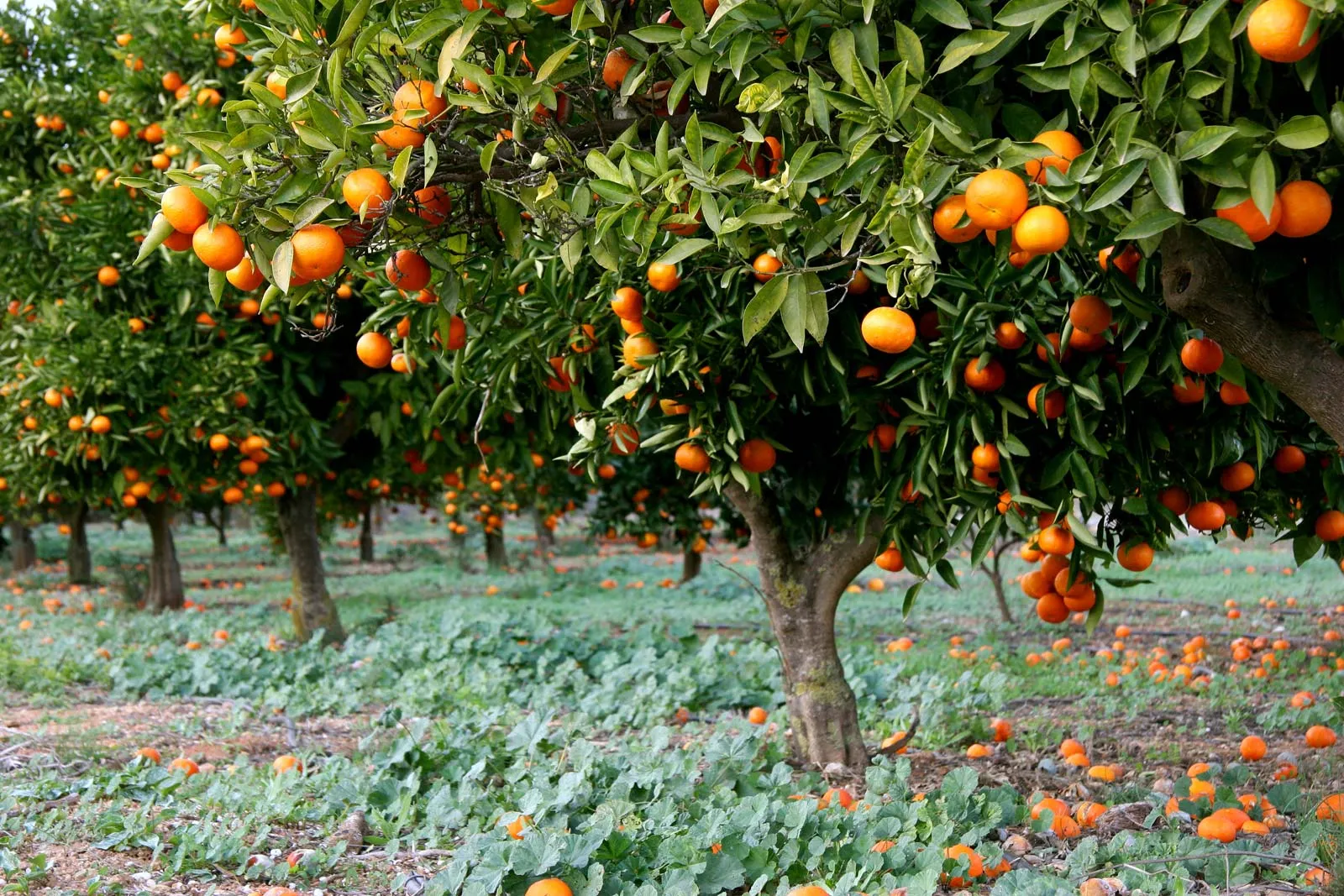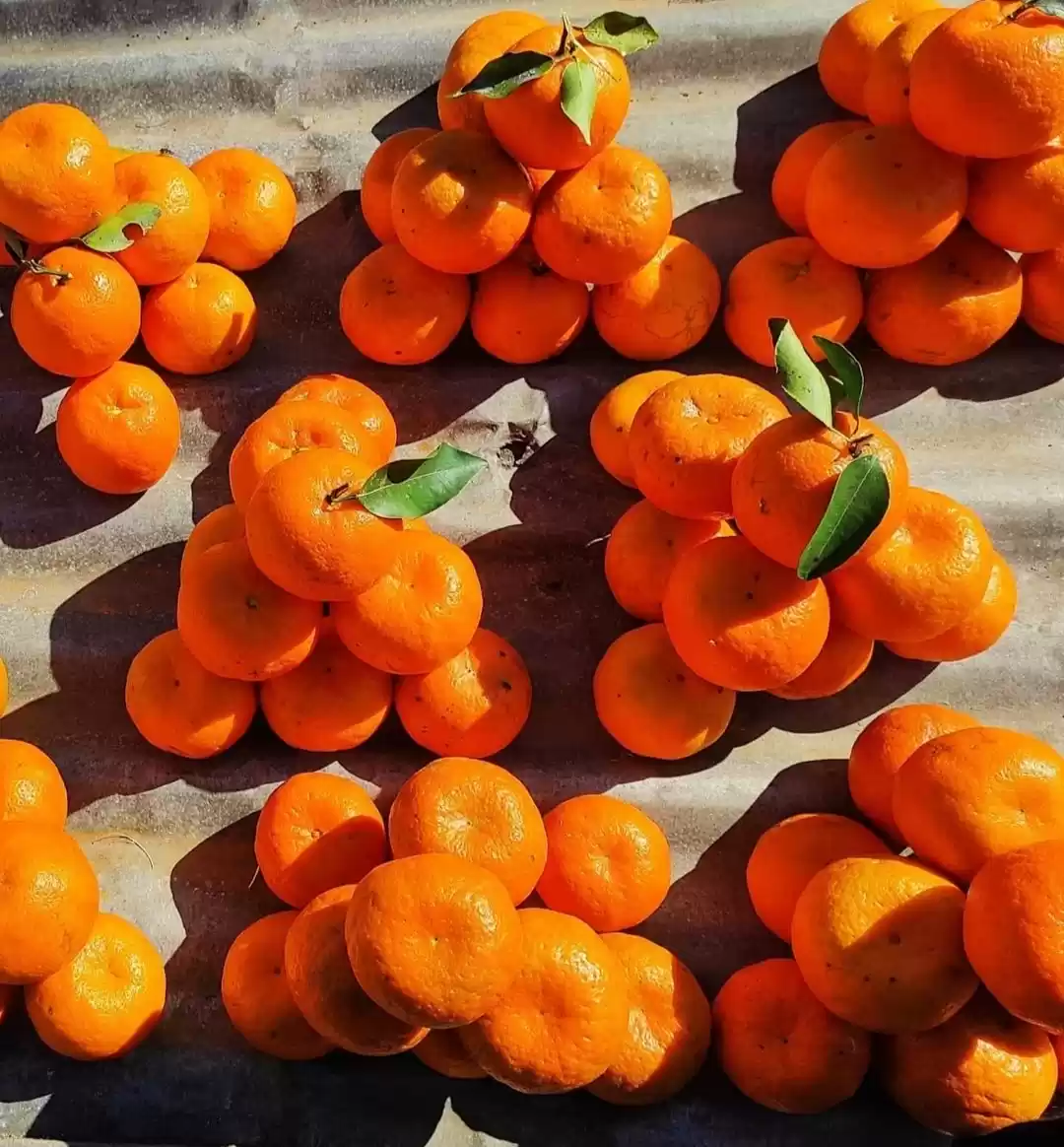
Summary of Contents
Introduction
The mandarin orange (Citrus reticulata) is a beloved citrus fruit known for its sweet taste, easy-to-peel skin, and abundant health benefits. Grown widely across the world, mandarin oranges have found a special place in the heart of Northeast India’s agricultural landscape, particularly in states like Arunachal Pradesh and Meghalaya. Often referred to as the “royal fruit” of the region, mandarin oranges offer more than just their delightful taste. They are a symbol of tradition, economic growth, and sustainability, making them a cornerstone of the local economy.
From its cultural significance to its health benefits, the mandarin orange is an essential part of the diet, lifestyle, and economy of the people in these regions. In this blog, we will explore the fascinating history, cultivation methods, and economic potential of mandarin oranges, especially in Northeast India.
Natural Habitat and Varieties
Mandarin oranges thrive in subtropical climates, with a preference for areas with warm, temperate weather and ample sunlight. Northeast India’s hilly terrain and climate provide the perfect environment for these citrus trees to grow and flourish.
Natural Habitat
Mandarin oranges are native to Southeast Asia, particularly China, but over the centuries, they have spread across the world. In India, they are predominantly grown in the northeastern states, including Arunachal Pradesh, Meghalaya, and Assam. These areas provide the right mix of high altitudes, fertile soil, and suitable weather conditions for successful mandarin orange cultivation.
Family and Genus
The mandarin orange belongs to the Rutaceae family, which includes other citrus fruits like lemons, limes, and grapefruits. Botanically, it is part of the genus Citrus, which includes multiple varieties of oranges and tangerines.
Varieties
In Northeast India, there are several notable varieties of mandarin oranges, each with its unique flavor profile and growing characteristics:
- Khasi Mandarin: Grown predominantly in Meghalaya, this variety is known for its sweet taste and juiciness.
- Arunachal Orange: A variety found in Arunachal Pradesh, it is highly sought after for its tangy sweetness and vibrant color.
- Darjeeling Mandarin: While primarily grown in the hills of West Bengal, this variety is also cultivated in Northeast India due to its adaptability to cooler climates.

History and Tradition in Northeast India
The cultivation of mandarin oranges in Northeast India is a deeply rooted tradition, dating back centuries. These citrus fruits have become an integral part of the region’s cultural heritage, with their cultivation practices passed down through generations. Traditional farming methods, such as terrace farming and organic practices, continue to be employed by many small-scale farmers. Beyond their agricultural significance, mandarin oranges hold significant cultural value, symbolizing prosperity and abundance. They are often used in religious ceremonies, festivals, and as gifts during auspicious occasions.
- Introduction: Mandarin oranges were likely introduced to Northeast India by traders or travelers from Southeast Asia, particularly China.
- Adaptation: Over time, the fruit adapted to the region’s unique climate and soil conditions, giving rise to distinct local varieties.
- Traditional Cultivation: Small-scale farmers continue to use traditional methods, such as terrace farming and organic practices, to cultivate mandarin oranges.
Cultural Significance
Mandarin oranges play a vital role in the cultural fabric of Northeast India, symbolizing prosperity, abundance, and good fortune.
- Gift-Giving: Mandarin oranges are frequently exchanged as gifts during festivals, weddings, and other auspicious occasions.
- Festive Celebrations: The Orange Festival in Dambuk, Arunachal Pradesh, is a prominent event celebrating mandarin orange cultivation and local culture.
- Religious Significance: Mandarin oranges are often used in religious ceremonies and rituals, symbolizing purity and offerings to deities.
- Traditional Cuisine: Mandarin oranges are incorporated into various local dishes and beverages, adding a unique flavor profile.
The cultivation of mandarin oranges in Northeast India is not merely an agricultural practice but a deeply rooted cultural tradition. It reflects the region’s rich history, values, and way of life.
Health Benefits of Mandarin Oranges
Mandarin oranges are packed with nutrients that make them a must-have in any diet. From boosting immunity to improving skin health, the benefits of mandarin oranges are numerous.

Rich in Vitamin C
Mandarin oranges are an excellent source of Vitamin C, which helps boost the immune system, protect against infections, and reduce inflammation. A single mandarin provides about 26% of the daily recommended intake of Vitamin C.
- Immune System Support: Mandarin oranges are packed with vitamin C, a powerful antioxidant that strengthens the immune system and protects against infections.
- Collagen Production: Vitamin C is essential for collagen production, a protein that supports skin health and connective tissues.
- Iron Absorption: Vitamin C enhances iron absorption from the body, preventing iron deficiency anemia.
Promotes Healthy Skin
The antioxidants in mandarin oranges help protect skin cells from damage, promoting youthful and glowing skin. Regular consumption of the fruit can reduce wrinkles and blemishes, making it a natural anti-aging remedy.
- Antioxidant Protection: The antioxidants in mandarin oranges help protect skin cells from damage caused by free radicals, reducing the appearance of wrinkles and fine lines.
- Youthful Glow: Regular consumption of mandarin oranges can promote a healthy and radiant complexion.
- Sun Protection: While not a substitute for sunscreen, the antioxidants in mandarin oranges can help protect the skin from sun damage.
Aids in Digestion
The fiber content in mandarin oranges helps improve digestion and prevents common gastrointestinal issues like constipation. Consuming mandarins regularly promotes a healthy digestive tract.
- Fiber Content: Mandarin oranges are a good source of fiber, which aids in digestion, prevents constipation, and promotes a healthy gut.
- Blood Sugar Regulation: The fiber in mandarin oranges can help regulate blood sugar levels, making them beneficial for individuals with diabetes.
- Gut Microbiome: The fiber in mandarin oranges can also support a healthy gut microbiome, which is essential for overall digestive health.
Supports Heart Health
The potassium and fiber in mandarin oranges contribute to better cardiovascular health. They help regulate blood pressure and reduce the risk of heart disease by lowering cholesterol levels.
- Potassium: Mandarin oranges contain potassium, a mineral essential for maintaining healthy blood pressure.
- Cholesterol Reduction: The fiber in mandarin oranges can help lower cholesterol levels, reducing the risk of heart disease.
- Blood Vessel Health: Potassium and fiber work together to support the health of blood vessels, reducing the risk of stroke and other cardiovascular diseases.
Aids in Weight Management
With their low calorie content and high fiber, mandarin oranges are a great snack for those looking to manage their weight. They provide a feeling of fullness without adding excess calories.
- Low Calorie: Mandarin oranges are a low-calorie snack that can help with weight management.
- Fiber Content: The fiber in mandarin oranges promotes satiety, helping you feel full and satisfied.
- Metabolic Boost: The nutrients in mandarin oranges can help boost metabolism, aiding in weight loss and maintenance.
Ideal Growing Conditions
Mandarin oranges require specific conditions to thrive, and Northeast India offers many of these naturally, making it an ideal region for cultivation.

Climate
Mandarin oranges grow best in subtropical climates where temperatures range between 10°C to 30°C. These plants can tolerate mild frost, but harsh winters can be detrimental to their growth. Northeast India offers the right climate, with a combination of warmth and cool breezes that help mandarin trees flourish.
- Mild Temperatures: Mandarin oranges thrive in subtropical climates with temperatures ranging from 10°C to 30°C.
- Frost Tolerance: While they can tolerate mild frost, harsh winters can be detrimental to their growth.
- Northeast India’s Ideal Climate: The region’s combination of warmth and cool breezes provides an excellent environment for mandarin orange cultivation
Soil Conditions and Terrain
Mandarin oranges require well-drained, loamy soil rich in organic matter. The hilly terrains of Meghalaya and Arunachal Pradesh provide an ideal growing environment, as the elevation helps with drainage and the soil retains enough moisture to nourish the trees.
- Well-Drained Soil: Mandarin oranges require well-drained, loamy soil rich in organic matter.
- Hilly Terrain: The hilly terrains of Meghalaya and Arunachal Pradesh offer ideal soil conditions and drainage.
Sunlight, Water, and Drainage
Mandarin trees need plenty of sunlight—at least 6-8 hours per day—to ensure good fruit development. Regular watering is necessary, but the soil should have proper drainage to prevent waterlogging, which can cause root rot.
- Adequate Sunlight: Mandarin trees need at least 6-8 hours of sunlight per day for optimal growth and fruit development.
- Regular Watering: Consistent watering is essential, but excessive moisture can lead to root rot. Proper drainage is crucial.
Season to Plant and Time Required to Grow
The best season to plant mandarin oranges is in spring or early summer. The trees take about 3-4 years to bear fruit, with full productivity often achieved in 6-8 years.
- Best Planting Season: Spring or early summer is the ideal time to plant mandarin orange trees.
- Time to Bear Fruit: Trees typically take 3-4 years to start bearing fruit, with full productivity often achieved within 6-8 years.
Best Organic Farming Techniques
As the demand for organic produce continues to rise, farmers in Northeast India are increasingly adopting sustainable and organic farming practices for mandarin orange cultivation. These methods prioritize environmental sustainability, human health, and animal welfare.
- Compost: Using compost derived from organic waste helps enrich the soil with nutrients, improve soil structure, and enhance water retention.
- Organic Fertilizers: Cow manure and other organic fertilizers provide essential nutrients to the trees without the use of synthetic chemicals.
- Biological Pest Control: Natural predators, beneficial insects, and organic pesticides are used to manage pests, reducing reliance on harmful chemicals.
- Mulching: Mulching with organic materials like leaves, straw, or grass clippings helps retain soil moisture, protect against weeds, and regulate soil temperature.
- Intercropping: Planting mandarin oranges with companion crops like ginger, turmeric, or legumes can enhance soil fertility and biodiversity. Legumes, for example, can fix nitrogen in the soil.
- Crop Rotation: Rotating mandarin oranges with cover crops like alfalfa or cowpea helps replenish soil nutrients, prevent pest and disease buildup, and improve soil structure.
By implementing these organic farming techniques, farmers in Northeast India can produce high-quality, organic mandarin oranges while preserving the environment and promoting sustainable agriculture.
Economic Impact
The mandarin orange industry plays a pivotal role in the economy of Northeast India, offering significant income and employment opportunities for local communities.

Market Dynamics
- Growing Demand: The market for mandarin oranges in Northeast India is expanding rapidly, driven by increasing consumer preference for organic and high-quality fruits.
- Infrastructure Gap: Despite the growing demand, the lack of adequate infrastructure and market access presents challenges for farmers in maximizing their profits.
Investment and Profitability
- Initial Investment: Cultivating mandarin oranges on 1 acre of land typically requires an initial investment of ₹1.5 lakh to ₹2 lakh to cover costs such as saplings, organic fertilizers, and labor.
- Yield and Profit: Mandarin orange trees can yield up to 10-15 tons per acre, depending on the variety and growing conditions. With average prices ranging from ₹50 to ₹80 per kg, farmers can expect substantial profits once the trees reach full production.
Employment Opportunities
- Job Creation: The mandarin orange industry provides employment for thousands of farmers and workers in Northeast India, from cultivation to harvesting and packaging.
- Rural Livelihoods: The sector offers a stable income source for rural communities, contributing to their economic development.
Domestic and International Markets
- Local Demand: The local demand for mandarin oranges in Northeast India is strong, driven by consumer preferences and cultural significance.
- Export Potential: The high quality of Northeast India’s mandarin oranges makes them attractive to international markets, particularly in the Middle East, Europe, and North America.
To fully capitalize on the economic potential of mandarin oranges, it is crucial to invest in infrastructure development, improve market access, and promote organic and sustainable farming practices. By addressing these challenges, the mandarin orange industry can continue to thrive and contribute to the economic growth of Northeast India.
Challenges in Growing Oranges
Despite the significant economic potential, mandarin orange farming in Northeast India faces several challenges that can impact production and profitability.
Pests and Diseases
- Fruit Flies: These pests can cause significant damage to mandarin oranges, reducing fruit quality and yield.
- Citrus Greening: This bacterial disease can weaken trees and reduce fruit production, posing a major threat to the industry.
- Organic Pest Control: While organic pest control methods can be effective, they may not always be sufficient to completely eliminate pest infestations.
Climate Vulnerability
- Extreme Weather: Excessive rainfall or prolonged drought can negatively affect mandarin orange trees, impacting fruit development and yield.
- Frost and Freezing: Young trees are particularly susceptible to frost and freezing temperatures, which can cause damage or death.
- Climate Change: Climate change poses increasing risks to mandarin orange cultivation, including more frequent and intense extreme weather events.
Market Access
- Reduced Profitability: Limited market access can reduce profitability for small-scale farmers, as they may be forced to sell their produce at lower prices to local buyers.
- Limited Infrastructure: Remote areas in Northeast India often lack modern packaging and transportation facilities, hindering access to larger markets.
Everyday Uses of Oranges
Mandarin oranges are truly a versatile fruit, offering a wide range of culinary and therapeutic applications. Whether enjoyed fresh or in various products, they provide a delicious and nutritious addition to any diet.

Culinary Applications
- Fresh Fruit: Mandarin oranges are delicious when eaten fresh, offering a burst of sweet and tangy flavor.
- Salads and Desserts: They add a refreshing element to salads and can be used in various desserts, such as fruit salads, cakes, and pies.
- Juices: Mandarin orange juice is a popular beverage that retains the fruit’s natural sweetness and nutritional benefits.
- Zest and Peel: The zest and peel of mandarin oranges can be used to add a citrusy flavor to baked goods, marinades, and sauces.
Therapeutic Uses
- Aromatherapy: Mandarin orange essential oil is widely used in aromatherapy to reduce stress, anxiety, and promote relaxation.
- Calming Effects: The sweet and calming scent of mandarin orange can help improve mood and reduce feelings of stress.
- Bath Oils and Diffusers: The essential oil can be added to bath oils or used in diffusers to create a relaxing atmosphere.
Value-Added Products
- Mandarin Orange Essential Oil: Extracted from the peel, this oil is used in aromatherapy, skincare products, and perfumes.
- Mandarin Orange Juice: A popular beverage that is often pasteurized or concentrated for extended shelf life.
- Candied Mandarin Peel: The peel of mandarin oranges can be candied and enjoyed as a sweet snack or used as a topping for desserts.
- Marmalades and Jams: Mandarin oranges can be used to make delicious marmalades and jams, which can be enjoyed on toast or used in baking.
Conclusion
Mandarin oranges are more than just a delicious and nutritious fruit; they are an integral part of the economy, culture, and agricultural landscape of Northeast India. As demand for organic produce continues to rise, the cultivation of mandarin oranges offers exciting opportunities for both farmers and investors. By embracing sustainable farming methods and improving market access, Northeast India’s mandarin oranges could soon find their way into homes worldwide.
For more insights on the diverse crops of this region, explore our Top 20 Crops in Northeast India, and discover the agricultural treasures that the Northeast offers.
FAQ Section
Q: Are mandarin orange cups good for you?
A: Yes, mandarin orange cups retain many of the nutrients found in fresh fruit, including Vitamin C and fiber, making them a healthy snack option.
Q: What is the Orange Festival?
A: The Orange Festival is an annual event held in Dambuk, Arunachal Pradesh, celebrating the region’s famous mandarin oranges with music, food, and cultural performances.
Q: Is mandarin orange farming profitable?
A: Yes, mandarin orange farming is highly profitable in Northeast India due to the fruit’s high demand, both locally and internationally.
Q: When is mandarin orange season?
A: Mandarin orange season in Northeast India typically runs from November to February, depending on the region and variety.
Q: Can mandarin orange trees survive winter?
A: Mandarin orange trees can tolerate mild winter conditions, but harsh frosts can damage the trees, especially younger ones.
Q: How long does it take to grow a mandarin tree?
A: It takes about 3-4 years for a mandarin tree to bear fruit and about 6-8 years for it to reach full production.
Q: How much does a mandarin orange tree yield?
A: A mature mandarin orange tree can yield about 100-200 kg of fruit annually, depending on the growing conditions.
Q: What is the price of mandarin oranges per kg?
A: The price of mandarin oranges can range from ₹50–₹80 per kg, depending on quality and market demand.
Q: Which orange is best in Arunachal Pradesh?
A: Arunachal Mandarin Orange more commonly known as Wakro Orange is the oldest cultivated fruit crop of the State. The famed juicy oranges are round-shaped with a sweet-sour taste.
Q: Which oranges are best in Meghalaya?
A: The Khasi Mandarin is the best orange variety in Meghalaya, known for its juicy, sweet flavor and high demand in local markets.
